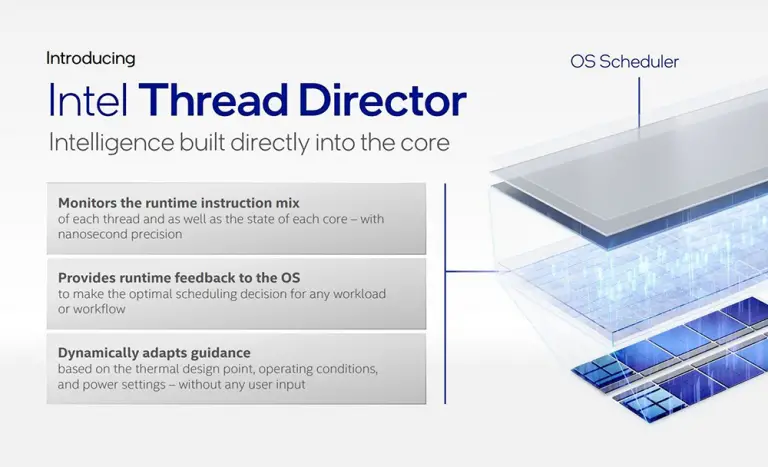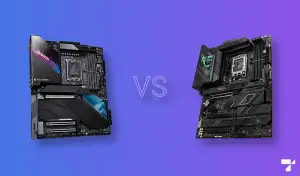During Intel’s Architecture Day 2021, the company confirmed that it would launch its 12th-generation Alder Lake processors, bringing about much faster performance in Windows 11 computers while also utilizing less power. The processor will optimize both the performance and efficiency of computers by utilizing Intel Thread Director technology along with windows 11.
What Is Intel Thread Director?
Intel Thread Director is a hardware-based scheduler that works in tandem with the operating system (OS) such as Windows 11 to assign the right computational task to the proper core or thread in order to achieve maximum real-world performance and efficiency.
In simpler terms, the Intel thread director helps the computer prioritize the critical tasks or applications that require high performance by placing them on the performance cores (P-Core) and then shifting the background tasks to the efficiency cores (E-Core), thereby saving power and maximizing system performance.
Intel’s proposal to model its Alder Lake CPUs using this hybrid architecture by introducing small, high-efficiency cores raised a few eyebrows. The technology is not unprecedented as small, high-efficiency cores have always been used in mobile phones to preserve battery life. In fact, many modern mobile phones now have three separate cores: super high-performance cores, regular high-performance cores, and high-efficiency cores. These cores handled different tasks with the aid of a scheduler. The scheduler assigns the small or background tasks to the E-core (efficiency cores) while allowing the P-cores (performance cores) to handle the heavy applications.
Intel seeks to explore this same type of technology in Alder Lake CPUs for optimum performance and longer system battery life. However, since the process is more complex for Intel’s Alder Lake CPUs given their new architecture, Intel introduced a hardware scheduler called the Thread Director to help the operating system make critical decisions on assigning tasks to the proper cores and threads efficiently.
How Does the Intel Thread Director Work?
Intel’s 12th-generation Alder Lake CPU is modeled on a hybrid architecture that combines performance cores and efficiency cores. The high-efficiency Gracemount cores are modeled to handle the background applications to ensure that maximum power is conserved. The high-performance Golden Cove cores are designed to handle the foreground tasks to ensure that the system runs optimally.
The P-cores and E-cores have specific functions and are designed to optimize the performance and efficiency of the desktop operating systems, especially Windows 11. To facilitate the integration of the two types of cores with the OS, Intel developed a Thread Director that gives runtime feedbacks to the Operating System, which then uses the information to ensure that the right thread is placed in the right core at all times for optimal system performance.
The P-cores handle the heavy workload, while the E-cores are used for the less demanding tasks and background applications that do not require much power. Whenever a user plays games or runs Photoshop on the desktop, the thread director instructs the operating system to place that task on the P-Core for maximum user experience. As for the applications running in the background, the thread director instructs the OS to assign it to the E-Core for efficient power conservation.
Since the roles of the two types of cores are defined, the thread director helps the Operating System make accurate scheduling decisions by putting power where it is needed and saving energy where it is not. This helps to reduce processing and load times while preventing system lag.
Operating Systems already have software schedulers that are used to assign threads to cores. However, the technology was not as advanced in the past to deliver optimal performance. Intel collaborated effectively with Microsoft to ensure that the Windows 11 OS had an efficient software scheduler.
The thread director monitors the state of the cores and each thread’s runtime instruction mix within nanoseconds and relays runtime feedback to the operating system on the type of threads that should be given higher priority based on factors like the thermal design power and other operating conditions. The operating system’s software scheduler then uses this information to assign threads to the right cores.
The Intel thread director technology has eliminated the guesswork involved in the work of the software scheduler. The thread director provides instructions after it assesses the performance and efficiency rating of each task. With its input, the software scheduler can now make critical decisions in the most timely manner to allow optimal system performance and reduce battery consumption.
What to Expect from the Launch of Intel’s 12th-Generation Alder Lake
The Intel Thread Director is one of the best features to anticipate in the new 12th-Gen Alder Lake. According to Intel, the thread director support and the Alder Lake have been tailored to the specifications of the Windows 11 Operating System. However, it also confirmed that Windows 10 Operating System would witness some level of improvement. Subsequently, Intel would collaborate with other Operating System companies to incorporate the thread director technology.
It is anticipated that Intel will launch Alder Lake on November 19th, 2021 as they confirmed that the new product would be launched towards the end of 2021. And this is further supported by the fact that Microsoft may also plan to release Windows 11 in October.
Details around the new product’s pricing, performance, architecture, and functionality will remain unclear until the product is officially released.
Final Thoughts
Intel and Microsoft have invested a significant amount of time, money, and effort into the Alder Lake CPU project. Despite the skepticism from critics and the raised expectations from technology enthusiasts, there is no doubt that the success of this project will be key to further outstanding breakthroughs in the future.



